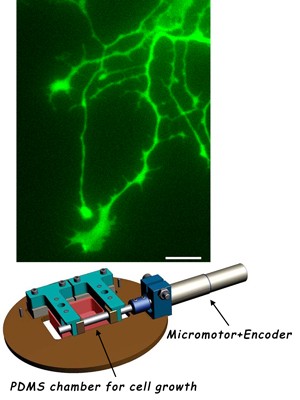The work of assistant Professor Shelly Tzlil is an enlightening example of interdisciplinary research: in her undergrad degree she completed a dual major in chemistry and computer science, her graduate research (MSc and PhD) was in physical chemistry, and her postdoc focused on polymer chemistry. She is a biophysicist, who started off as a theoretician turned experimentalist and today study mechanical sensing in living cells at the Faculty of Mechanical Engineering.

“In light of this phenomenon, the identity of the investigator and his discipline, greatly affects the type of research questions raised. “While physicists and chemists will ask – ‘How do cells sense elasticity?’ biologists might ask – ‘What is the evolutionary advantage of such a mechanism?’ And medical doctors would want to know how such a mechanism will manifest itself in health and disease,” explains Assistant Professor Tzlil. “I am interested in exploring how cells are able to ‘feel’ the mechanics of their environment, and how they communicate by deforming their environment mechanically.”
“Mechanical engineers study the way material responds to mechanical forces, and how to measure and apply them. They view the cell as a machine with control mechanism and this drive them to ask different type of questions, such as ‘how does the cell ‘know’ how much force to apply?’ It’s a different way of thinking. In interdisciplinary work of this kind both sides have to make an effort to understand one another. I found this willingness in the Faculty of Mechanical Engineering.”
The Technion is a natural playground for this type of interdisciplinary work. “At the Technion the collaboration between medicine and engineering already exists, and I knew I’d be able to find a multidisciplinary working environment that would both suit me and enrich me. My research requires a continuous dialogue with engineers, biologists, medical doctors, theoreticians and experimentalists and the Technion is an ideal place for such integration. Theoretically, I could have found myself in biology, biotechnology engineering or biomedical engineering. The advantage of working in mechanical engineering for me is the toolbox I have here – and of course the excellent partners I’ve made in the fields of elasticity, dynamics and more. I bring to the mechanical engineering faculty the biological aspect, the study of soft matter and the focus on the cellular and molecular levels – aspects that do not belong to traditional areas of mechanical engineering. I came here because I thought that this interaction between the two worlds can lead to an interesting outcome.”
***
Shelly Tzlil was born in Rishon LeZion, and all of her degrees – her undergrad in chemistry and computer science, and her graduate degree in physical chemistry were completed at the Hebrew University in Jerusalem. In her doctoral studies she investigated processes such as the mechanics of DNA packaging in viruses, and protein adsorption on membranes. “My doctoral thesis was in theoretical biophysics – developing models that can explain biological processes. Over time, I realized that as a theoretician, I’m dependant on experimentalists to perform the experiments that interest me. As an experimentalist, I can design and conduct my own experiments to test our theories.”
Tzlil has done her postdoc at Caltech, working with Professor Dave Tirrell, a polymer chemist. “Tirrell knows how to “program” bacteria to operate as a polymer factory producing artificial proteins with unique functionalities.”
The research currently being conducted at Associate Professor Tzlil’s laboratory examines the implications of mechanical interactions between cells and the biological mechanism that enables it. Additionally, new biomaterials are designed that are able to increase the range of mechanical interaction between cells and simulate the physiological environment.
“Usually, biological interactions based on chemical or electrical signals are short range. Mechanical interactions can be felt in large distances. Cardiac cells, for example, can sense mechanical forces hundreds of microns away. It implies that cardiac cells can ‘feel’ each other and synchronize their beating without physical contact, especially when they are on an elastic substrate characteristic of a healthy tissue.”
Assistant Professor Shelly Tzlil believes that her research will enable the design of materials that will allow control over the rate and direction of nerve cell growth after injury. “As part of the research I’m developing bio-materials that increase the range of mechanical interactions between cells as well as materials that simulate the mechanical physiological environment,” explains Prof. Tzlil. “Materials that can effectively conduct mechanical deformations have the potential to control the rate and direction of nerve cell growth after injury.”
